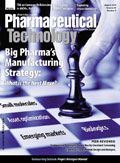Green Drug Delivery: Spray-dried solid amorphous dispersions with a cellulosic exicpient
Green chemistry in pharmaceutical development often centers around approaches in the synthesis of the active ingredient, but green-chemistry techniques also can be applied to drug-product manufacturing, formulation development, and drug delivery.
Although the application of green chemistry in pharmaceutical development often centers around approaches in the synthesis of the active ingredient, green-chemistry techniques also can be applied to drug-product manufacturing, formulation development, and drug delivery. One such example is spray-dried solid amorphous dispersion technology based on hydroxypropyl methylcellulose acetate succinate (HPMCAS) as a green drug-delivery technology. The approach, which is used by Bend Research (Bend, OR), a drug-delivery technology firm, was an entry in the 2010 US Environmental Protection Agency Presidential Green Chemistry Challenge Awards. Entries for the awards apply green-chemistry technology and were announced in late June (1).
HPMCAS is an amphiphilic polymer. Its hydrophobic regions can interact with low-solubility drug molecules, and its hydrophilic regions allow the drug–HPMCAS structures to form stable colloids in aqueous solutions. HPMCAS forms amorphous dispersions with low-solubility drugs for use in solid oral dosage forms (1). Bend Research uses HPMCAS spray-dried dispersions (SDDs) as a solubilization strategy for poorly water-soluble drugs.
SDDs are single-phase amorphous molecular dispersions of a drug in a polymer matrix, which provide several benefits as a solubilization technique. They enhance the oral absorption of poorly water-soluble compounds by attaining and sustaining a supersaturated concentration of the drug in the gastrointestinal tract. They also may be applied to a wide range of insoluble compounds with various physicochemical properties. SDDs are also physically stable, which allows for long-term storage in various conditions without amorphous phase separation or crystallization of the drug (2).
The greenness of HPMCAS-SDDs results from the material itself and the manufacturing process. As a cellulosic excipient, HPMCAS is made from renewable resources (1). Efficient solvent use in the manufacturing process contributes to the greenness of this approach. SDDs are obtained by dissolving drug and polymer in a solvent, typically acetone or methanol. The solvent rapidly evaporates from the droplets to solidify the polymer and the drug mixture, thereby trapping the drug as an amorphous molecular dispersion. Only the drug and HPMCAS are dissolved in the organic solvent (e.g., acetone ad methanol) or as mixtures of these solvents with water. The dispersion is spray dried, and the solvent is recovered for reuse (1, 2).
The HPMCAS–SDDs also provide an efficient drug-delivery mechanism. The drug as an SDD is in a high-energy state compared with the crystalline drug, and when placed in an aqueous solution, SDDs dissolve in a concentration of drug above the solubility of its lowest-solubility crystalline form. The higher concentration of drug facilitates the rapid absorption (2). The improved bioavailability of the low-solubility drug reduces the amount of active pharmaceutical ingredient (API) needed for therapeutic results, thereby creating an efficient drug-delivery mechanism. The more economical use of the API is an overall benefit as it reduces the need for additional chemical production of a given API.
More than 400 drug candidates have been formulated successfully as HPMCAS–SDDs. Twenty-eight compounds have advanced to clinical development (1). The HPMCAS–SDD approach was used in the formulation of torcetrapib, a drug developed by Pfizer (New York) as a potential successor to Lipitor (atorvastatin) until Pfizer stopped Phase III development (3).
The HPMCAS–SDD technology can be applied to various regulatory filings. In December 2009, Bend Research reported that a reference Type V Drug Master File (DMF) for HPMCAS could be used for regulatory filings with US Food and Drug Administration, according to a December 2009 Bend Research press release. A letter of authorization allows FDA to reference the Type V DMF for investigational new drug, new drug, and abbreviated new drug applications.
The Type V DMF for HPMCAS was filed with FDA in 2005 by Pfizer, which was the sponsor of Bend Research's work investigating the use of HPMCAS to improve drug solubility. This Type V DMF contains supplemental nonclinical safety data—including absorption, distribution, metabolism, and excretion data—to support chronic and high-dosage use of HPMCAS as an excipient for human oral delivery. The Type V DMF supplements the DMF filed by Shin-Etsu Chemical (Tokyo) and provides additional data to support the use of HPMCAS in SDDs for improving oral drug bioavailability.
Sources
1. EPA, The Presidential Green Chemistry Challenge Awards Program: Sum mary of 2010 Award Entries and Recipients (EPA, Washington, DC, 2010).
2. D. T. Friesen, Mol Pharm. 5 (6), 1003–1019 (2008).
3. A. Thayer, Chem. Eng. News 88 (22), 13–18 (2010).

Drug Solutions Podcast: A Closer Look at mRNA in Oncology and Vaccines
April 30th 2024In this episode fo the Drug Solutions Podcast, etherna’s vice-president of Technology and Innovation, Stefaan De Koker, discusses the merits and challenges of using mRNA as the foundation for therapeutics in oncology as well as for vaccines.
Drug Solutions Podcast: Applying Appropriate Analytics to Drug Development
March 26th 2024In this episode of the Drug Solutions Podcast, Jan Bekker, Vice President of Business Development, Commercial and Technical Operations at BioCina, discusses the latest analytical tools and their applications in the drug development market.